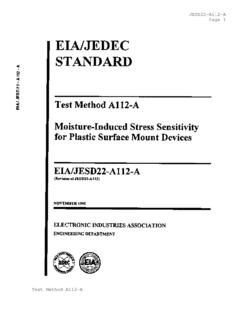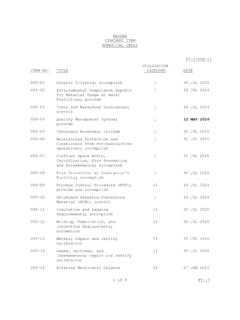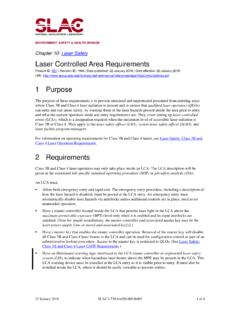Transcription of Laser Fundamentals - Naval Sea Systems Command
1 Laser Fundamentals INTRODUCTION The word " Laser " is an acronym for Light Amplification by Stimulated Emission of Radiation. Lasers are finding ever increasing military applications -- principally for target acquisition, fire control, and training. These lasers are termed rangefinders, target designators, and direct-fire simulators. Lasers are also being used in communications, Laser radars (LIDAR), landing Systems , Laser pointers, guidance Systems , scanners, metal working, photography, holography, and medicine. In this document the word Laser will be limited to electromagnetic radiation emitting devices using light amplification by stimulated emission of radiation at wavelengths from 180 nanometers to 1 millimeter.
2 The electromagnetic spectrum includes energy ranging from gamma rays to electricity. Figure 1 illustrates the total electromagnetic spectrum and wavelengths of the various regions. Figure 1. Electromagnetic Spectrum The primary wavelengths of Laser radiation for current military and commercial applications include the ultraviolet, visible, and infrared regions of the spectrum. Ultraviolet radiation for lasers consists of wavelengths between 180 and 400 nm. The visible region consists of radiation with wavelengths between 400 and 700 nm. This is the portion we call visible light.
3 The infrared region of the spectrum consists of radiation with wavelengths between 700 nm and 1 mm. Laser radiation absorbed by the skin penetrates only a few layers. In the eye, visible and near infrared radiation passes through the cornea, and is focused on and absorbed by the retina. It is the wavelength of the light that determines the visible sensation of color: violet at 400 nm, red at 700 nm, and the other colors of the visible spectrum in between. When radiation is absorbed, the effect on the absorbing biological tissue is either photochemical, thermal, or mechanical: in the ultraviolet region, the action is primarily photochemical; in the infrared region, the action is primarily thermal; and in the visible region, both effects are present.
4 When the intensity of the radiation is sufficiently high, damage to the absorbing tissue will result. Laser THEORY AND OPERATION A basic understanding of how a Laser operates helps in understanding the hazards when using a Laser device. Figure 2 shows that electromagnetic radiation is emitted whenever a charged particle such as an electron gives up energy. This happens every time an electron drops from a higher energy state, Q1, to a lower energy state, Q0, in an atom or ion as occurs in a fluorescent light. This also happens from changes in the vibrational or rotational state of molecules.
5 The color of light is determined by its frequency or wavelength. The shorter wavelengths are the ultraviolet and the longer wavelengths are the infrared. The smallest particle of light energy is described by quantum mechanics as a photon. The energy, E, of a photon is determined by its frequency, , and Planck's constant, h. vhE = (1) The velocity of light in a vacuum, c, is 300 million meters per second. The wavelength, , of light is related to from the following equation: c= (2) The difference in energy levels across which an excited electron drops determines the wavelength of the emitted light.
6 Figure 2. Emission of radiation from an atom by transition of an electron from a higher energy state to a lower energy state COMPONENTS OF A Laser As shown in figure 3, the three basic components of a Laser are: Lasing material (crystal, gas, semiconductor, dye, ) Pump source (adds energy to the lasing material , flash lamp, electrical current to cause electron collisions, radiation from a Laser , etc.) Optical cavity consisting of reflectors to act as the feedback mechanism for light amplification Figure 3. Solid State Laser Diagram Electrons in the atoms of the lasing material normally reside in a steady-state lower energy level.
7 When light energy from the flashlamp is added to the atoms of the lasing material, the majority of the electrons are excited to a higher energy level a phenomenon known as population inversion. This is an unstable condition for these electrons. They will stay in this state for a short time and then decay back to their original energy state. This decay occurs in two ways: spontaneous decay the electrons simply fall to their ground state while emitting randomly directed photons; and stimulated decay the photons from spontaneous decaying electrons strike other excited electrons which causes them to fall to their ground state.
8 This stimulated transition will release energy in the form of photons of light that travel in phase at the same wavelength and in the same direction as the incident photon. If the direction is parallel to the optical axis, the emitted photons travel back and forth in the optical cavity through the lasing material between the totally reflecting mirror and the partially reflecting mirror. The light energy is amplified in this manner until sufficient energy is built up for a burst of Laser light to be transmitted through the partially reflecting mirror. As shown in figure 4, a lasing medium must have at least one excited (metastable) state where electrons can be trapped long enough (microseconds to milliseconds) for a population inversion to occur.
9 Although Laser action is possible with only two energy levels, most lasers have four or more levels. Figure 4. Three level Laser energy diagram A Q-switch in the optical path is a method of providing Laser pulses of an extremely short time duration. A rotating prism like the total reflector in figure 3 was an early method of providing Q-switching. Only at the point of rotation when there is a clear optical path will light energy be allowed to pass. A normally opaque electro-optical device ( , a Pockels cell) is now often used for a Q-switching device. At the time of voltage application, the device becomes transparent, the light built up in the cavity by excited atoms can then reach the mirror so that the cavity Quality, Q, increases to a high level and emits a high peak power Laser pulse of a few nanoseconds duration.
10 When the phases of different frequency modes of a Laser are synchronized (locked together), these modes will interfere with each other and generate a beat effect. The result is a Laser output with regularly spaced pulsations called "mode locking". Mode locked lasers usually produce trains of pulses with a duration of a few picoseconds to nanoseconds resulting in higher peak powers than the same Laser operating in the Q-switched mode. Pulsed lasers are often designed to produce repetitive pulses. The pulse repetition frequency, prf, as well as pulse width is extremely important in evaluating biological effects.



















